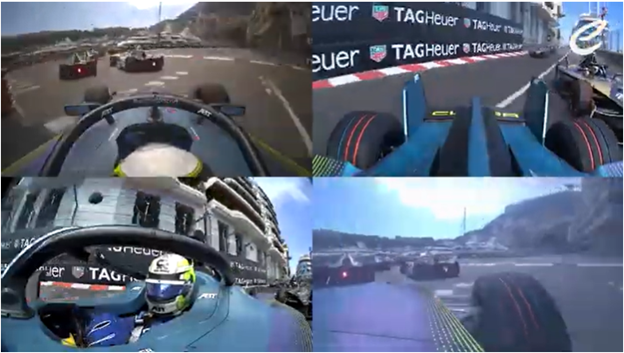Collaboration allows for multiple cameras in all competing race cars, facilitating simultaneous transmission from all 22 vehicles whilst recording onboard video with over-air playback.
Southampton and London, UK — Working in collaboration, Domo Broadcast Systems, Timeline TV and Formula E Technology have successfully deployed a never-before-seen solution that allows for the distribution of 220 on-board cameras across all 22 cars in a single race. This innovative and ground-breaking technology enables the transmission of multiple camera angles simultaneously or individually, with seamless built-in switching, real-time over-air playback, and remote operator control of multiple cameras.
This transformative work has not only greatly enhanced viewer experience, but also opened up new data sharing opportunities that will improve production and potentially enhance driver safety. The remote production capabilities of this cutting-edge solution have already resulted in significant financial and resource savings.
The audience for Formula E racing has been rapidly growing year on year, with 2022 seeing an impressive 20% increase in global viewership, reaching a staggering 381 million viewers. A 58% rise in total viewing hours further underscores the impact improved broadcast presentation has on viewership. Formula E, driven by the commitment to solidify its position as a mainstream sport for the next generation, partnered with Timeline Television and Domo Broadcast Systems to elevate the viewer experience to unprecedented heights. The goal was to provide viewers with a unique in-car perspective never seen before in motorsport broadcasting.
Eric Ernst, Technology Director at Formula E, commented: “Today’s audience is looking for a more-immersive experience when it comes to watching racing. They are increasingly used to gaming and virtual reality experiences that place them in the driver’s seat. As a result, they’re no longer satisfied with seeing a race from behind the barriers, with the occasional, brief shot from inside a race car. We needed to continue to push the boundaries of what’s been done before and take our content offering to as yet unseen levels.
“Prior to the bespoke efforts of Timeline and Domo Broadcast, it wasn’t possible to cut between on-board cameras, go direct to air, or preview the coverage coming from multiple on-board cameras.”
Motorsport has specific broadcasting requirements, including the need for live, 4K ultra-high definition (UHD) transmission of events taking place at high speeds so viewers get to see high-quality images.
“Before we introduced a new system in January of this year, on-board cameras had mostly been 1080i-50 cameras,” explains Tony Northmore, Head of RF Development at Timeline. “This new system runs in 1080P50 and can do HDR. It wasn’t possible to cut synchronously between a car’s on-board cameras. You had to cut away to a track-side camera, switch the car camera, then cut back to the car.”
All that changed at the start of 2023. By the time of the Formula E race in Monaco in May, the team had managed to offer a complete on-board lap, cutting synchronously between 10 cameras — with no break-up.
Other improvements include an enhanced viewer experience through the T-forward camera — the camera providing the iconic shot of the entire car from the roll-hood. It now has a 1-inch (2.5 cm) UHD sensor that can be panned left and right within the UHD image whilst live, providing even more capability to deliver the perfect shot of some of the fastest action in motorsport.
The new system has an on-board recorder that can record eight of the 10 car cameras. If a crash is missed or a camera wasn’t turned on, live replays are possible direct from the car, delivering the missing shots in real time into the programme. In addition, the FIA take all 13 live feeds, and if there is a crash or incident, they can ask Timeline’s production team to replay footage for them in a timely manner for them to review. This additional information can be used to aid scrutineering and is of huge assistance to the FIA team.
Once the transmission is decoded, all streams are sent back to London via a 17 21 10-7 stream. The control system extends from the circuit to the remote production gallery as well, allowing the production team in London access to the same interface and oversight that they would have at the circuit.
This remote production capability from so many cameras is economically and environmentally significant. Not only is it providing extremely high-quality content, but it is also reducing the number of resources needed on site, including people, and the associated financial and environmental costs that go hand in hand with having people on site for a world series.
“The ability of the teams at Domo Broadcast, Timeline and the Formula E Technology department to work closely, share knowledge and put in the effort to create the bespoke solution have been key to our ability to enhance viewer engagement so significantly this year, particularly as we try to bring our fans closer to the action on the track,” says Aarti Dabas, Chief Media Officer at Formula E.
“The achievements made by Domo Broadcast Systems, Timeline TV and Formula E Technology have set a new standard in sports coverage, particularly for sports involving multiple participants and locations, and necessitating UHD quality at high speeds,” says Mike Budge, Broadcast Unit Director for Domo Broadcast Systems. “The ongoing commitment of Timeline and Domo Broadcast Systems to create future-proof solutions that can easily incorporate the latest technological advancements ensures that their work in this domain will continue to evolve and revolutionise the field.”
Watch the onboard cameras in action here:

